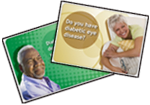Educational
Resource Spotlight: Diabetic Eye Disease
E-cards
Healthy Vision Community Programs Database

This easy-to-search resource can help you learn about new ways to address eye health issues and replicate eye health-related projects in your community. Visit the Healthy Vision Community Programs Database at
www.nei.nih.gov/hvcpdatabase.
The National Eye Health Education Program is coordinated by the National Eye Institute, National Institutes of Health, U.S. Department of Health and Human Services. This administrative document may be reprinted without permission.
In This Issue:
-
NEHEP Launches New Diabetes and Healthy Eyes Toolkit for Community Health Workers
-
Make a Difference—Educate Your Community About Diabetic Eye Disease
-
New CDC Website Supports Health Communication and Social Marketing Practice
-
First EyeSmart™ EyeCheck Vision Screenings Conducted in Los Angeles
-
Healthy Vision Community Awards Spotlight: Roanoke City, Virginia, Health Department

Letter From the Chair of the NEHEP Planning Committee
November has been declared “American Diabetes Month” by the American Diabetes Association and “Diabetic Eye Disease Month” by Prevent Blindness America. These observances offer a great opportunity to get the word out about how critically important it is for people with diabetes to have a dilated eye exam at least once a year in order to maintain the best vision possible.
Diabetes is the leading cause of new cases of blindness across the extremely broad age range from 20 to 74 years, with diabetic retinopathy responsible for 12,000 to 24,000 new cases of blindness each year.1 According to a study in a recent issue of the Journal of the American Medical Association, nearly 30 percent of adults in the United States over the age of 40 who have diabetes are estimated to have diabetic retinopathy, with about 4 percent of this population having vision-threatening retinopathy.2
Because certain eye diseases arise sooner and more frequently in people with diabetes,3 the term “diabetic eye disease” is often used to refer to eye problems such as diabetic retinopathy, glaucoma, and cataract. Ethnicity is known to be a factor in disease prevalence; in particular, Hispanics/Latinos have higher rates of diabetes and are at higher risk for diabetic eye disease.4
Beyond having disparate rates of disease, Hispanics/Latinos are doubly impacted by other disparities having public health implications. An in-depth survey sponsored by the National Eye Institute and Lions Clubs International Foundation known as the Knowledge, Attitudes, and Practices Related to Eye Health and Disease Survey (KAP survey) found that only 37 percent of Hispanics/Latinos had heard of diabetic eye disease as compared with 52 percent of non-Hispanic adults.5
There are times when the prospects for health education to make a difference seem promising. For example, 77 percent of adults with diabetic eye disease report knowing that vision loss caused by diabetes can be prevented as compared with 69 percent of all adults.5 At other times, the general level of understanding about health risks is concerning. Particularly alarming, for instance, are the KAP survey results that show only 11 percent of adults with DED and 11 percent of all adults report knowing that eye disease caused by diabetes usually has no early warning signs.5 We need to reinforce the message that severe consequences can emerge without early symptoms, underscoring the importance of regular eye examinations.
As the prevalence of diabetes rises, diabetic retinopathy can be expected to rise along with it, unless preventive action is taken. Because early diagnosis, timely treatment, and follow-up have been shown to prevent vision loss in more than 90 percent of patients,6 healthcare practice guidelines recommend a dilated eye exam at least once a year for all people with diabetes.3 Although the KAP survey results show that all adults with DED and 85 percent of all adults report knowing that people with diabetes should have a dilated eye exam at least once a year,5 there is room for health education efforts to improve understanding and follow-through on regular eye exams, for both patients and health professionals. These efforts can contribute to improvement in the overall quality of care.
It will take year-round dedication on the part of eye care professionals to raise awareness about proper eye health for people with diabetes. This issue of Outlook introduces several new NEHEP resources, including a new toolkit for community health workers to use in educating people about diabetic eye disease, and e-cards that can be sent to people with diabetes, as well as to their family and friends who provide support, to remind them of the need to have dilated eye examinations. You will also find articles on health education and outreach strategies to use with people who have diabetes.
We invite you to contact us and let us know more about the ways you are addressing diabetic eye disease through your health education efforts. Also, as always, we welcome input on ideas for articles that you would like to see in future issues of Outlook. We look forward to hearing from you.Anne Louise Coleman, M.D., Ph.D.
Chair, National Eye Health Education Program Planning Committee
Frances and Ray Stark Professor of Ophthalmology
Jules Stein Eye Institute
David Geffen School of Medicine at UCLA
and
Professor of Epidemiology
UCLA School of Public Health
References
1 |
Centers for Disease Control and Prevention. (2008). Number of people with diabetes continues to increase. Retrieved from http://www.cdc.gov/Features/diabetesFactSheet/ |
2 |
Zhang, X., Saaddine, J., Chou, C-F., Cotch, M., Cheng, Y., Geiss, L., & Klein, R. (2010). Prevalence of diabetic retinopathy in the United States, 2005-2008. Journal of the American Medical Association, 304(6), 649–656. |
3 |
American Diabetes Association. (2010). Standards of medical care in diabetes—2010. Diabetes Care,33(S1), S11-S61. Retrieved from http://care.diabetesjournals.org/content/33/Supplement_1/S11.full.pdf+html |
4 |
Varma, R., Torres, M., Peña, F., Klein, R., & Azen, S. P.; Los Angeles Latino Eye Study Group. (2004). Prevalence of diabetic retinopathy in adult Latinos: The Los Angeles Latino Eye Study. Ophthalmology, 111(7), 1298–1306. |
5 |
National Eye Institute & Lions Clubs International Foundation. (2007). Appendix K: Knowledge, attitudes, and practices subanalyses. 2005 survey of public knowledge, attitudes, and practices related to eye health and disease (Page 12). Bethesda, MD: National Eye Institute. Retrieved from http://www.nei.nih.gov/kap/2005KAPFinalRpt.pdf |
6 |
Ferris, F. L. (1993). How effective are treatments for diabetic retinopathy? Journal of the American Medical Association, 269(10),1290–1291. |
Reflections on NEHEP
 It is hard to believe that the National Eye Health Education Program (NEHEP) was launched in 1991, almost 20 years ago. At that time, there were just a handful of organizations addressing eye health education. Today, there are hundreds of organizations in communities across the country that have made eye health a priority.
It is hard to believe that the National Eye Health Education Program (NEHEP) was launched in 1991, almost 20 years ago. At that time, there were just a handful of organizations addressing eye health education. Today, there are hundreds of organizations in communities across the country that have made eye health a priority.
It was always my opinion that a role of government was to fill the gaps found in eye health education, with a primary focus on reaching those at higher risk for eye disease. I believe we accomplished that.
However, we did not do that alone, but with the help of the NEHEP Partnership. The Partnership has grown over the years, with each organization committed to educating communities about the importance of early detection and treatment of eye diseases. While the Partnership represents national organizations, many of them have taken our important eye health messages to the local level where the need is great. Working hand in hand is making a difference.
As time goes on, we all need to review where we have been and where we are going. New challenges face eye health education, yet new challenges bring new opportunities. We will continue to stay true to our founding principles of educating those at higher risk for eye disease with science-based programs.
The time is right for me to step down as the director of NEHEP. I still remain the Associate Director for Communication, Health Education, and Public Liaison at NEI, but effective October 1, 2010, Neyal Ammary-Risch became the new director of NEHEP. She has been with NEI for more than five years and has been responsible for many of the new initiatives we have today. With her leadership, NEHEP will thrive with new perspectives and fresh ideas. Join me in congratulating Neyal and wishing her well.
Rosemary “Rosie” Janiszewski
NEHEP Launches New Diabetes and Healthy Eyes Toolkit for Community Health Workers
 Community health workers play an integral role in helping people with diabetes manage all aspects of their disease, especially in Hispanic/Latino communities. The National Eye Health Education Program (NEHEP) has developed a new Diabetes and Healthy Eyes Toolkit to help educate people about diabetes and its eye complications. Available in both English and Spanish, the Toolkit contains science-based, user-friendly materials about diabetes and eye health that enable community health workers to provide sight-saving information to groups of people with diabetes, as well as their family and friends.
Community health workers play an integral role in helping people with diabetes manage all aspects of their disease, especially in Hispanic/Latino communities. The National Eye Health Education Program (NEHEP) has developed a new Diabetes and Healthy Eyes Toolkit to help educate people about diabetes and its eye complications. Available in both English and Spanish, the Toolkit contains science-based, user-friendly materials about diabetes and eye health that enable community health workers to provide sight-saving information to groups of people with diabetes, as well as their family and friends.
This comprehensive Toolkit features a variety of resources:
- A flipchart with talking points and colorful graphics for use in small group settings.
- A module that provides step-by-step guidance, information, and activities for delivering an educational workshop on diabetic eye disease.
- A full-color photonovella-style booklet about the importance of proper eye care for people with diabetes and other diabetic eye disease materials.
- An order form for bulk quantities of educational materials.
- An evaluation form.
- A CD with printable versions of the flipchart, module, and other educational materials.
By using the Toolkit and other resources available from NEHEP, community health workers can play a crucial role in educating people with diabetes about the importance of getting a comprehensive dilated eye exam at least once a year and seeking the appropriate follow-up care for eye diseases.
If you are a community health worker or work with them in your programs, order a copy of the Toolkit today! Materials are also available for download. To learn more, visit http://www.nei.nih.gov/diabetestoolkit/.
NEHEP would like to acknowledge the following organizations for contributing to the development of the module and flipchart that are part of the Diabetes and Healthy Eyes Toolkit:
- The staff at the Midwest Latino Health Research, Training, and Policy Center at the University of Illinois at Chicago (UIC Latino Research Center) for laying the groundwork for the module and flipchart.
- The National Alliance for Hispanic Health for conducting discussion groups with their network of community lay health workers.
- The members of the NEHEP Diabetic Eye Disease Subcommittee for reviewing materials for scientific accuracy.
- The health promoters who tested the Diabetes and Healthy Eyes Toolkit in the field and provided invaluable feedback.
Providing Effective Education to People With Diabetes
Diabetes has become an epidemic in the United States, and projections for new cases in the coming years are alarming. According to the Centers for Disease Control and Prevention, diabetes is the leading cause of new cases of blindness among adults aged 20–74 years, with diabetic retinopathy causing 12,000 to 24,000 new cases of blindness each year.1
Frequent communication is essential to assist people with diabetes in managing their disease and to ensure that they are aware of and receive necessary eye care.2 To sustain the positive effects of short-term diabetes interventions, patients require ongoing support over the long term.2 Continued follow-up with healthcare providers can benefit patients by helping them gain a better understanding of diabetes management, and of theoretical principles underlying patient empowerment.2 Providing educational materials that take health knowledge, literacy level, and overall health into account is also critical and can help improve patients’ ability to manage their disease.3
 |
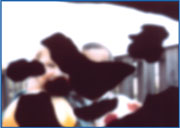 |
| Normal Vision | Vision with Diabetic Retinopathy |
Outreach strategies should focus not only on educating people with diabetes, but also on the healthcare professionals who are in contact with them. Healthcare professionals provide direct access to people with diabetes who are in the medical care system and can serve as the most credible source of eye health information and referrals. In particular, primary care physicians can play a vital role in preserving vision in their patients by encouraging appropriate disease management and by ensuring patients undergo periodic evaluations by eye care professionals to receive needed eye care.
Community-based diabetes support and education groups can help to establish trusting, caring relationships over time and bridge communication gaps between patients and providers. Forming partnerships with diabetes-related healthcare providers can play a major role in making this happen. In fact, using as many channels of communication as possible will help provide avenues for message repetition, an important factor in raising awareness and knowledge and in motivating people to take action.
Organizations within the community can offer direct access to people with diabetes, can distribute information, and can help provide referrals to services. Together with interpersonal delivery, community channels can form a strong support network, with each channel reinforcing the message, encouraging those at risk to seek more information and to schedule an eye examination. Community outlets for information about diabetic eye disease include community health centers, health maintenance organizations, hospital outpatient clinics and emergency rooms, churches, and supermarkets, among others.
The National Eye Health Education Program (NEHEP) provides a variety of materials and resources you can use in your outreach efforts. To find ideas and resources, visit http://www.nei.nih.gov/nehep/programs/diabeticeyedisease.
Read more about Effective Education to Target Populations at
http://www.nei.nih.gov/nehep/research/Effective_Education_to_
Target_Populations.pdf.
References
1 |
Centers for Disease Control and Prevention. (2008). Number of people with diabetes continues to increase. Retrieved from http://www.cdc.gov/Features/diabetesFactSheet/ |
2 |
National Eye Health Education Program. (2006). Appendix D: Effective education to target populations. National Eye Health Education Program (NEHEP) five-year agenda (D1-D23). Retrieved from http://www.nei.nih.gov/nehep/docs/nehep_5_year_agenda_2006.pdf |
3 |
Kleinbeck, C. (2005). Reaching positive diabetes outcomes for patients with low literacy. Home Healthcare Nurse, 23(1), 16–22. |
Send a Diabetic Eye Disease E-card
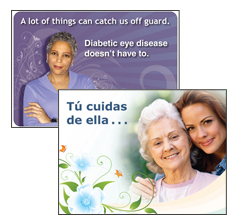 New e-cards are now available to help remind people with diabetes and those who care for them about the importance of comprehensive dilated eye exams in protecting their vision. These e-cards, available in English and Spanish, reinforce the message that diabetic eye disease has no early warning signs and that it’s important to have a dilated eye exam at least once a year to detect eye disease before vision loss has occurred.
New e-cards are now available to help remind people with diabetes and those who care for them about the importance of comprehensive dilated eye exams in protecting their vision. These e-cards, available in English and Spanish, reinforce the message that diabetic eye disease has no early warning signs and that it’s important to have a dilated eye exam at least once a year to detect eye disease before vision loss has occurred.
All people with diabetes, both type 1 and type 2, are at risk for vision loss from diabetic eye disease. Help spread the word about the importance of dilated eye exams by sending a personalized e-card to someone with diabetes whom you care about or by providing a link to the e-cards on your website for others to send. Each of these cards provides a link back to the National Eye Institute Diabetic Eye Disease Education Webpage for recipients to get more information about the eye complications of diabetes and what they can do to protect their sight.
Send an English e-card.
Send a Spanish e-card.
Make a Difference—Educate Your Community About Diabetic Eye Disease
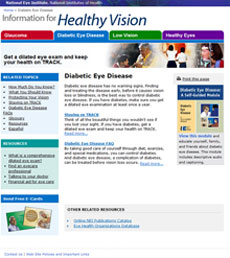 Diabetic eye disease (DED) is a complication of diabetes that includes diabetic retinopathy, cataract, and glaucoma. All can cause severe vision loss or blindness. There are often no symptoms in the early stages of DED, which is why it is so important for people with diabetes to have a dilated eye exam at least once a year to detect eye disease in its early stages. In fact, early diagnosis, timely treatment, and follow-up have been shown to prevent vision loss in more than 90 percent of patients.1
Diabetic eye disease (DED) is a complication of diabetes that includes diabetic retinopathy, cataract, and glaucoma. All can cause severe vision loss or blindness. There are often no symptoms in the early stages of DED, which is why it is so important for people with diabetes to have a dilated eye exam at least once a year to detect eye disease in its early stages. In fact, early diagnosis, timely treatment, and follow-up have been shown to prevent vision loss in more than 90 percent of patients.1
You can observe American Diabetes Month this November by helping to raise public awareness about the need for people with diabetes to have dilated eye exams. Share information with people in your community, as well as with family, friends, and colleagues. The National Eye Health Education Program (NEHEP) has a variety of materials in English and Spanish available to help you. In addition to the new Diabetes and Healthy Eyes Toolkit and diabetic eye disease e-cards described in this issue of Outlook, the following are examples of materials and resources with ideas about how to use them. You can find these materials as well as additional ideas for outreach at http://www.nei.nih.gov/nehep/programs/diabeticeyedisease.
Medicare Benefit Card
What You Can Do: Help others obtain the diabetic eye disease and glaucoma benefit under Medicare. The card (available in English and Spanish) contains information about benefit eligibility and where to go to learn more.
How You Can Do It: Distribute this card at health fairs, clinics, and other community locations. Place the cards in your cafeteria or lunch room with a note to “Take one for someone you care about.” Work with local pharmacies to make the cards available to their customers.
DED Education Website
What You Can Do: Link others to a consumer-friendly site where they can learn about early detection, treatment, and follow-up care for diabetic eye disease.
How You Can Do It: Post the link on your intranet or website. Include information about the website in e-mails and newsletters to your constituents.
¡Ojo con su visión! (Watch Out for Your Vision!)—Photonovella
What You Can Do: Help those in the Hispanic/Latino community better understand diabetes and the importance of having a dilated eye exam at least once a year.
How You Can Do It: Distribute this newly revised, full-color booklet at locations that provide programs to the Hispanic/Latino community, such as community clinics and centers, libraries, and houses of worship.
Don’t Lose Sight of Diabetic Eye Disease Brochure
What You Can Do: Make sure that eye care professionals in your community know about this brochure, which is available in English and Spanish.
How You Can Do It: Stop in at local eye care professionals’ offices and ask them to make it available to their patients. Leave a copy and be sure to provide information about how they can order a free supply.
Print and Radio Public Service Announcements (PSAs)
What You Can Do: Enlist the mass media. NEI offers a variety of downloadable print and radio PSA scripts about the importance of dilated eye exams.
How You Can Do It: Use NEI ready-made scripts to record PSAs that your organization can play on your hold line or distribute to local radio stations. Download print PSAs, available in a variety of sizes, and ask the editor of your local newspaper to run them.
Don’t Lose Sight of Diabetic Eye Disease Drop-in Article
What You Can Do: Let people with diabetes and those who care about them know about the importance of having a dilated eye exam at least once a year.
How You Can Do It: Put this article in your company or organizational newsletter or post it on your company bulletin board or intranet. Contact the marketing or health education department at the nearest hospital to see if they can place the article in the publication that they produce and distribute to the community. Get in touch with a newspaper health editor and request that the article be printed.Reference
1 |
Ferris, F. L. (1993). How effective are treatments for diabetic retinopathy? Journal of the American Medical Association, 269(10),1290–1291. |
New CDC Website Supports Health Communication and Social Marketing Practice
 A new Centers for Disease Control and Prevention (CDC) Website, The Gateway to Health Communication and Social Marketing Practice, has a wealth of information that can help you build your social marketing or health communication campaigns or programs. Whether you are looking for tips to help analyze and segment an audience, choose appropriate channels and tools, or evaluate the success of your messages or campaigns, the Gateway can help you find what you need to achieve your goals.
A new Centers for Disease Control and Prevention (CDC) Website, The Gateway to Health Communication and Social Marketing Practice, has a wealth of information that can help you build your social marketing or health communication campaigns or programs. Whether you are looking for tips to help analyze and segment an audience, choose appropriate channels and tools, or evaluate the success of your messages or campaigns, the Gateway can help you find what you need to achieve your goals.
The Health Communication and Social Marketing Essentials section of the website offers step-by-step advice on developing a health communication or social marketing campaign. The site takes information from CDC and other public and private resources and creates six distinct categories, making it easier for you to find exactly what you need. The categories include—
- Audience: How to identify, segment, select, and target audiences; and tailor your health messages to reach your intended audiences.
- Campaigns: A thorough list of CDC and other health campaigns, plus other health communication materials and interventions, where you can find "best practices" and interventions that really work.
- Research/Evaluation: Where you will find formative and summative research, plus evaluation tools, for health communication programs.
- Channels: How to help you determine the best avenues for distributing, delivering, and promoting your outreach strategy.
- Tools & Templates: Where you can find templates, and social-media and health-literacy tools, among others, to help you create effective and successful campaigns.
- Risk Communication: Where you can learn about the principles of risk and crisis response, crisis and emergency risk communication, and issues management during emergencies.
The Gateway Blog addresses a new social marketing or health communication question every month, and provides a venue where professionals can engage in discussions on a wide range of topics. There is also a section entitled, Success Stories, where you can share what has worked well for you in the past and learn from others' experiences in the field.
If you have any questions or comments, contact Curt Shannon at cbq9@cdc.gov, or at 404-498-6696.
First EyeSmart™ EyeCheck Vision Screenings Conducted in Los Angeles
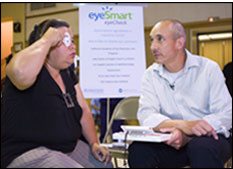
On July 25th, the American Academy of Ophthalmology (Academy) and its partners conducted the first EyeSmart™ EyeCheck vision screening. The program, which was announced in May, was created to combat undetected eye disease and visual impairment among at-risk populations in the United States. With new research from the Los Angeles Latino Eye Study (LALES) showing that Latinos have higher rates of visual impairment, the initial emphasis for the EyeSmart EyeCheck program is on the Latino community.
Twenty-nine volunteer ophthalmologists screened 499 patients at the Family Health Fair hosted by Lady Queen of Angels Church in Los Angeles. The physicians discovered that more than 50 percent of the patients were afflicted by some type of visual impairment and 70 percent needed follow-up care.
“The EyeSmart™ EyeCheck program is an important first step in addressing preventable vision loss in highly affected communities,” said Anne L. Coleman, M.D., Ph.D., director of the Academy’s H. Dunbar Hoskins, Jr., M.D., Center for Quality Eye Care; Frances and Ray Stark Professor of Ophthalmology; and Professor of Epidemiology at the UCLA Jules Stein Eye Institute. “We were thrilled to be a part of an event that was able to give back so much to so many.”
The incidence of multiple diseases in this community and in other at-risk populations prompted the Academy to adopt and promote a different approach to adult vision screenings. The new screening methodology focuses on detecting damage from eye disease rather than screening for eye disease. By taking this approach, the volunteer ophthalmologists at Sunday’s EyeSmart™EyeCheck event were able to see double the amount of patients than would have been possible through a traditional screening.
“Traditional adult vision screenings typically screen for a specific disease like glaucoma or cataracts,” added Dr. Coleman. “To get the greatest benefit from a screening, it makes sense to screen broadly for functional visual impairment. This allows us to screen more individuals in a given time.”
EyeCare America, a public service program of the Foundation of the American Academy of Ophthalmology, offers free eye care services to qualifying patients. The Academy’s EyeSmart™ EyeCheck program is working with EyeCare America and local hospitals, health departments, and community clinics to provide sources for follow-up treatment and care once a diagnosis is made.
For more information on the EyeSmart™ EyeCheck program, contact Allison Neves at aneves@aao.org, at 415-447-0385, or visit http://geteyesmart.org.
Healthy Vision Community Awards Spotlight: Roanoke City, Virginia, Health Department
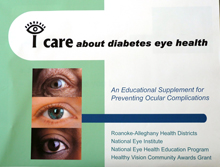 As a 2009 Healthy Vision Community Award (HVCA) recipient, the Roanoke City Health Department in Virginia focused its efforts on developing and implementing the i care about Diabetes Eye Health: An Educational Supplement for Preventing Ocular Complications curriculum. The first step taken in developing the project was to conduct a literature review to identify best practices in patient education, health behavior, adult learning, diabetes eye care, self-management, and educator training. Educational materials from the National Eye Health Education Program (NEHEP) were used as a starting point to develop a more comprehensive curriculum.
As a 2009 Healthy Vision Community Award (HVCA) recipient, the Roanoke City Health Department in Virginia focused its efforts on developing and implementing the i care about Diabetes Eye Health: An Educational Supplement for Preventing Ocular Complications curriculum. The first step taken in developing the project was to conduct a literature review to identify best practices in patient education, health behavior, adult learning, diabetes eye care, self-management, and educator training. Educational materials from the National Eye Health Education Program (NEHEP) were used as a starting point to develop a more comprehensive curriculum.
The Roanoke City Health Department started using the NEHEP Diabetic Eye Disease: An Educator’s Guide flipchart to train health educators and diabetes educators in the community, but found the information was too simple and that more detail was needed for their audience. They also found that the 8” x 10.5” flipchart was too small to be viewed easily in some venues and that not everyone had the equipment needed to show the PowerPoint slide version of the flipchart (available on the NEHEP Educator’s Guide CD.) To address these challenges, the health department modified the PowerPoint presentation on the CD by adding in some of their own slides to include additional information. To make the modified PowerPoint presentation look consistent with the one NEHEP developed, the health department used artwork from the flipchart and also used HVCA funds to create a 27” x 34” hardcopy flipchart based on the modified PowerPoint presentation.
The complete set of i care curriculum tools consists of 28 scripted slides; laminated photo eye disease simulation activity cards (normal vision, diabetic retinopathy, glaucoma, and cataract); a pre- and post-Eye-Q Knowledge Assessment; the booklet, Diabetic Retinopathy: What you should know; a TRACK magnet; and a Healthy Eye Action Plan. Additionally, a facilitator guide and train-the-trainer manual were developed and given to local diabetes educators along with information for ordering materials from NEHEP.
The curriculum was piloted three times at a local free clinic with groups of diabetes patients. A pre- and post-quiz was given to participants at each pilot session to assess their knowledge before and after the i care session. Patients were also asked to indicate if they ever had a dilated eye exam and the date of the last one. This information was used to create their Healthy Eyes Action Plan and to rate their confidence level for following through with the Plan. Patients who indicated a need for a dilated eye exam were offered educational materials and instructed to make an appointment with the volunteer project ophthalmologist. After each pilot session, evaluation information was gathered and used to revise and edit the scripts used by the presenters.
In addition to the pilot testing, one 70-minute train-the-trainer seminar was developed and provided free of charge to local diabetes educators. Three educators offered the i care session within their existing education program at a local diabetes management center. The project coordinator observed and evaluated these sessions to ensure the educators were effectively facilitating the components of the i care curriculum and to receive feedback on the ease in implementing the session with the materials provided.
For more information about the i care about Diabetes Eye Health: An Educational Supplement for Preventing Ocular Complications project, contact Dr. Stephanie L. Harper at 540-283-5050 or the project contact, Lanet Hall, at lanet.hall@vdh.virginia.gov.On the Road With NEI
![]() NEI regularly attends and exhibits at national meetings across the country. Exhibits and presentations provide an opportunity to share information and publications, promote NEI messages and resources, and strengthen links with Partnership organizations. An upcoming NEI presentation is listed below. If you plan to be there, please stop by and say “hello”!
NEI regularly attends and exhibits at national meetings across the country. Exhibits and presentations provide an opportunity to share information and publications, promote NEI messages and resources, and strengthen links with Partnership organizations. An upcoming NEI presentation is listed below. If you plan to be there, please stop by and say “hello”!
American Public Health Association
Annual Meeting
Colorado Convention Center
Denver, Colorado
November 6-10, 2010
Roundtable: Diabetes and Healthy Eyes Toolkit:
Helping Educate Hispanics/Latinos About Diabetic Eye Disease
Session 4175.0, Tuesday, November 9th, 12:30 p.m.
Join NEI staff as they discuss the prevalence of diabetes in the Hispanic/Latino community, the implications of diabetic eye disease in this population, and the features of its new Diabetes and Healthy Eyes Toolkit for community health workers. The Toolkit, available in English and Spanish, provides detailed guidance and instructional resources for educating people with diabetes about related eye disease complications in a community setting.
Let Us Know What You Think About Outlook
 NEHEP wants to know what you think about Outlook. Let us know what you find beneficial, ideas for content you would like to see in upcoming issues, or suggestions for improvement. We’re always interested in hearing about your eye health education efforts and especially how you have used NEI resources and materials.
NEHEP wants to know what you think about Outlook. Let us know what you find beneficial, ideas for content you would like to see in upcoming issues, or suggestions for improvement. We’re always interested in hearing about your eye health education efforts and especially how you have used NEI resources and materials.
Please contact us. We look forward to hearing from you!

